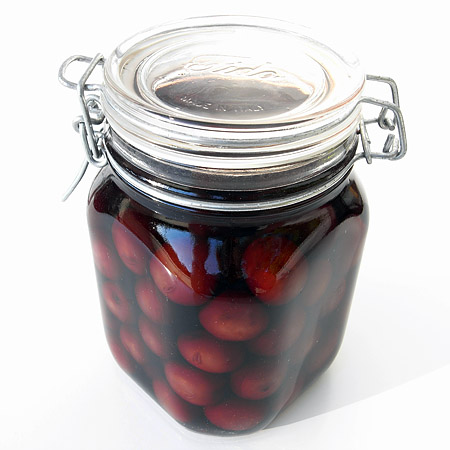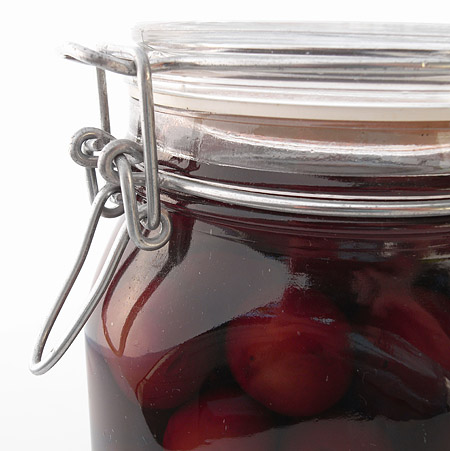
Extraction of cherries with ~45% ethanol in water
Ethanol is a molecule with both a polar and a non-polar end, so it’s properties are somewhat in between those of water and oil (which will be the topic of the next post in this series about extraction). This is easily illustrated by the fact that both water and oil are soluble in pure ethanol (albeit not at the same time – adding water to ethanol reduces the solubility of oil). Many taste molecules are polar whereas most aroma molecules are non-polar, and the good thing is that ethanol can be used to extract both groups of compounds.
I belive the most widespread use of ethanol for extractions in the kitchen is for sweet liqueurs where fruits or berries are extracted with ethanol and the extract is sweetened with sugar. The word liqueur comes from the Latin word liquifacere which means “to dissolve”, and this is essentially what happens – the ethanol and water extract and dissolve flavor and color from the fruit.
Some also make their own spirits by infusing spices and herbs. One example is aquavit which is based on carraway combined with a number of other spices for complexity such as dill, coriander, anis, fennel, liquorice, cardamom and lemon. Commercial aquavits are distilled, but at home it’s suffices to filter of the spices and herbs. As a result home made aquavits are always amber colored (such as the one pictured in a previous post).
For extractions like these, one always uses diluted ethanol, typically 30-60% ethanol in water would be used, and most often somewhere around 40-50%. One reason for this is that higher concentrations of ethanol would extract to many bitter and astringent compounds. Another reason is that in some (most?) countries it is illegal to posess, buy and/or sell ethanol at higher concentrations for consumption (pure ethanol for technical use is denatured if sold in normal stores and requires special permissions if used in laboratories).
Apart from the steping herbs and spices in ethanol to make liqueurs, the only other example of relevance for the kitchen I can think of is for extraction of vanilla beans to make pure vanilla extract. This is quite surprising actually, and although I really don’t know if ethanol is used for extraction in professional kitchens, it is my impression that ethanol extractions are underutilized in the kitchen.
There are several benefits with ethanolic spice and herb extracts:
- fast – no need to wait for the spices to be extracted since they have been “pre extracted”, you can taste the dish immediately and add more spice extract if necessary
- no residues – seeds, leaves or bark are filtered off before use
- convenient – spice extracts are an excellent way of adding clean, concentrated aromas
- stable – spice extracts keep very well (although the storage may also change the flavor profile somewhat and “mature” the flavor)
- new flavors – some spices and in particular herbs will change upon extraction and storage and this can open up new possibilities (this needs quite some experimentation though – some herb flavors change to the worse…)
What are your experiences with ethanol extractions in the kitchen?


In my kitchen I keep commercial extracts of vanilla, anise, and orange in the spice cabinet, and if I liked almonds that would be up there as well; extracts of anise and citrus are reasonably common in recipes. I use extract of orange regularly when oranges are not handy for zesting.
But you’re proposing home-extracting my own spices in alcohol? I tend to prefer buying whole spices and grinding them as needed; I can imagine supplementing my spice cupboard with vials of spices packed in liquor. Then I would probably strain the extract through a coffee filter as I add it to a dish. Is this your method, or do you have a different set-up?
I make my own Vanilla Extract at work don’t ues it often, but I just take the left over vanilla pod that has been scraped and throw it in a bottle of vodka.
Sounds like I should make some more non sweetened versions tho…we do make anise oil maybe anise ethanol hmmmm
Theo: Thanks for the information. I’ve googled a little and just found out that McCormick has a range of extracts in addition to vanilla including cinnamon, mint and peppermint in addition to the ones you mention.
Yes – spices can easily be extracted at home. Leave them for a week or a month (or even longer), tasting regularily to see how they develop. Since extracts are very concentrated I’d suggest you strain the whole batch through a coffee filter. The extracts would typically be added drop wise.
I use them for both beverage and trait extracts. I freequently will use a higher price ingredient that has a high amount of waste to make extracts or flavored vodkas.
Right now, I’ve from the baking side–coconut extract. I use that for all sort of cakes.
In my ‘medicine cabinet’, I have a meyer lemon vodka. I bought the meyer lemon towards the end of their season here in the states. I needed the juice of several of them for an event. But I seeped for several days the remaining bodies. The result is a very tasty flavored vodka. It has a slightly astringent character, but it works well when used as a mixer or blended with simple syrup to follow your lines of a liqueur.
Vodka here in the states is 80 proof. So, it’s not quite like working with the high ends AbV. It’s definitely a useful tool to stretch ingredients in my book.
I bet truffle extract would beat truffle oil hands down.
Your post reminds me of how the chemistry professors in my school used to complain about the 200 proof alcohol being tainted with benzene and how in the old days, you would just have cocktail parties in the university labs. Completely unsafe, but it was definitely alluring to many of us students wanting a cheap happy hour so many of my friends would try to obtain the 200 proof ethanol. Many more of them began fermenting their own beer and wine and I became a tolerable cook: to get them to bring over their fermented goodies.
I’ve noticed that more restaurant/bars are making their own extractions – some of them really delicious, others a bit too adventurous – in alcohol and in oil. It leads me to wonder if micelle technology could also be applied for greater distribution of flavor… but maybe that’s a stretch.
…200 proof alcohol being tainted with benzene…
It is very difficult to get dry ethanol, that is ethanol with only trace amounts of water, cheaply on a bulk scale. Dry ethanol is hygroscopic and will readily absorb water from the air; it also forms an azeotrope with water so the less water is present, the harder it is to remove. Commercial dry ethanol, sometimes called absolute ethanol, is dried by making an azeotrope with benzene (water binds more strongly to benzene than ethanol) followed by distillation.
There are very little amounts of benzene in ethanol from this method, so the complaints are more likely due to the increasing reluctance of lab people to consume products from their own lab. Logically, it would be silly to use ethanol in the lab that is contaminated with any significant amount of organic solvent.
When making ethanol extracts of spices, I find that a Soxhlet extraction works much more efficiently than soaking and filtration. It usually extracts the more volatile aromatic compounds first and leaves the heavier bitter tastes in the remnants.
We made vanilla extract at work using rum instead of vodka with the leftover vanilla seed pods. I think it adds a nice dimension…
I agree, Martin. Ethanol must be highly underutilised. Although liqueurs are quite common, my opinion is that non-sweetened drinks have a great potential. At least for those of us that prefer our spirits with less sugar and more flavour/aroma from the main ingredient, be it spices, berries, fruits or something else.
In my opinion, berry/fruit liqueurs and aquavits(*) are maybe the alcoholic drinks with greatest potential for making at home. Home-produced beer and wine are commonl, but require lots of specialst skill, experience and knowledge to even come close to the quality of the commercial versions. Extracted spirits, however, are very easy to make and the quality would easily surpass what you buy. Why? I guess that ethanol and sugar are the cheap ingredients, at least for industry, whereas i.e. high quality wild or garden-grown berries are expensive. Hence, according to my taste, these are ofter too sweet and lack flavour and aroma from the berries/fruit.
At home, we produce, almost every year, a batch of lingonberry liqueur or aquavit. The berries are hand-picked in nearby mountaineous areas, and the flavour is packed with berries. Another great spirit is blackberry leaf aquavit:
800 ml blackberry leaves, preferably picked before or during blossoming
700 ml 40% ethanol
4 sugar cubes
Cut the leaves in 2-4 with scissors, leave in the ethanol (closed jar) for two weeks. The recipe says one week in light and one week in the dark (does this make sense?). Filter off the leaves, add sugar cubes and leave for 3-4 months.
Yes, I know – measuring leaves by volume doesn’t seem very reproducible. However, depending on the weather, weight migh be just as inaccurate.
A wonderful golden colour and aroma of blackberries (obviously) and hints of brown spirits.
* Here, I use “aquavits” as a general term for non-sweetened spirits based on extraction. “Dram” is an alternative Norwegian/Danish word. A more proper English term might maybe be schnapps?
Do you know if vinegar extracts like alcohol (being that it once was alcohol) or does it have its own set of rules?
hank: Good quesiton! It’s true that ethanol can be oxidized to acetic acid (known as vinegar when diluted to 5-7%). In the process the polar OH group is converted into the much more polar COOH group (a carboxylic acid group). In other words, vinegar is more similar to water than to ethanol with regards to polarity. But there is an extra side to this – the fact that it’s an acid will help break down cell walls and allow for a more complete extraction than when using water.
Martin my brain is exploding trying to understand how this works. I understand that ethanol has a polar and non polar “end” but how does the OH group converting to a carboxylic group affect its non polar end? I noticed also that adding water to ethanol affects oil’s ability to be soluble in it. Is there a connection between these to things?
hank
The relative importance of the non-polar end is smaller when going from OH to COOH.
Yes – adding water to ethanol will dimish it’s ability to dissolve oil.
[…] and a non-polar end falls in between oil and water. I’ve covered extractions using water and ethanol previously. That water and oil are opposites is easily observed by the fact that they don’t […]
[…] in water however decreases with higher molecular weight. As I mentioned in a previous post on ethanol extractions this is the reason why 30-60% ethanol is most commonly used for infusions and […]
[…] ethanol can dissolve both water- and oil-soluble flavour compounds. (You can read more about this here.) In practical terms, this means that if you add an aromatic foodstuff to vodka and leave it to sit […]